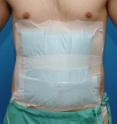The decision about the incision: Is midline or transverse better for abdominal surgery?
An unusual study at the Department of Surgery at Heidelberg University Hospital examined for the first time whether the incision technique used in major abdominal surgery had an effect on the results. Neither physician nor patient knew what kind of incision had been made. The study of 200 patients showed that pain perception and the healing process were unrelated to the technique used to open the abdominal cavity. Complications were also just as frequent, except for wound infections, which were more frequent for transverse incisions, possibly due to circulatory problems. The surgeons in Heidelberg thus recommend that the surgeon make an individual, case-by-case decision on the incision technique. The incision technique has thus far never been examined scientifically
Today, abdominal surgery is often done in a minimally invasive procedure using "keyhole surgery". But for large operations, the abdomen must still be opened with a long incision. "Whether this incision is transverse or midline depends mainly on the surgeon's preference and has thus far never been examined scientifically," Professor Markus W. Büchler, Director of the Department of Surgery at Heidelberg University Hospital.
This randomised trial was carried out according to international quality criteria to clarify definitively whether the two methods are equivalent and the surgeon is thus free to choose a technique, said Dr. Christoph Seller, consultant at the Department of General, Visceral, and Transplant Surgery and Chairman of the Study Center of the German Surgical Society in Heidelberg. The study was published in June 2009 in the "Annals of Surgery," the most important international journals for surgery.
How can a surgical trial be "blinded"?
A high quality clinical study on evaluating various therapies is done as a "double blind" study. This means that neither patient nor physician or nursing staff know what treatment a patient is given. The surgeon who performs the operation does not participate in gathering data. While still in the operating theater, a dressing is put on the patient, which is not removed until two days after the operation. Before it is removed, the amount of pain medication that was given is calculated and the patient assesses the pain using a scale. "The patients have no way of knowing how they were operated on," reports Dr. Seiler.
The consumption of pain medication and degree of pain immediately after the operation were the same for both procedures. There were also hardly any differences in long-term complications: The patients were examined twice, one month and one year after the surgery. The investigators tested possible consequences of the operation such as mortality, respiratory problems, digestive problems, length of hospitalization, scar ruptures, and wound infections. Statistically, there were no differences between the two groups – only wound infections were significantly more frequent for transverse incisions.
Dr. Seiler says, "This is difficult to explain. Perhaps it is linked to less control of bleeding or the higher risk of hematoma." He added that previous studies had not indicated a higher risk. The surgeons in Heidelberg thus draw the conclusion that there is thus a scientific basis for allowing the surgeon the free choice of incision technique.
Source: University Hospital Heidelberg
Other sources
- The decision about the incision: Is midline or transverse better for abdominal surgery?from PhysorgWed, 1 Jul 2009, 0:56:03 UTC
